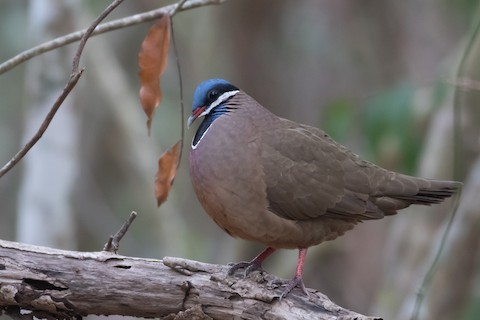Birdfinding.info ⇒ Rare, local, and declining. Easiest to see at two sites in southeastern Matanzas where the birds come into the open regularly at feeding stations: Cueva de los Peces and Vermejas Wildlife Refuge. It can sometimes be found along trails in Guanahacabibes, Viñales, and La Güira National Parks, and can turn up nearly anywhere in the Zapata Swamp area.
Blue-headed Quail-Dove
Starnoenas cyanocephala
Endemic to Cuba. Formerly occurred throughout Cuba and the Isle of Youth, but now mostly extirpated except from a few areas.
The Zapata Swamp and adjacent woodlands appear to be the last stronghold of this species. Small, fragmentary, remnant populations persist on the Guanahacabibes Peninsula, in the mountains of Pinar del Río and Artemisa, in Topes de Collantes, around Loma de Cunagua, and likely also in remote parts of the southeastern mountains.
Identification
Unique: warm-brown overall with an ornate blue, black, and white pattern on the head, neck, and chest. The legs and base of the bill are coral-red.
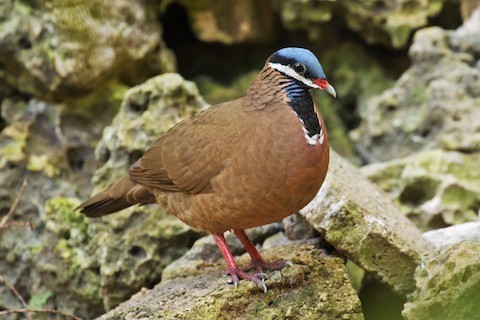
Blue-headed Quail-Dove. (Cueva de los Portales, Pinar del Río, Cuba; December 8, 2016.) © Jason Estep
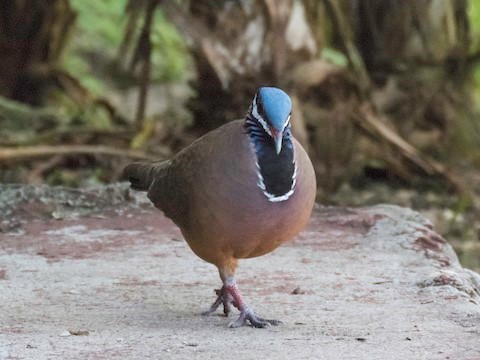
Blue-headed Quail-Dove. (Cueva de los Peces, Matanzas, Cuba; October 22, 2018.) © Sebastian Pardo
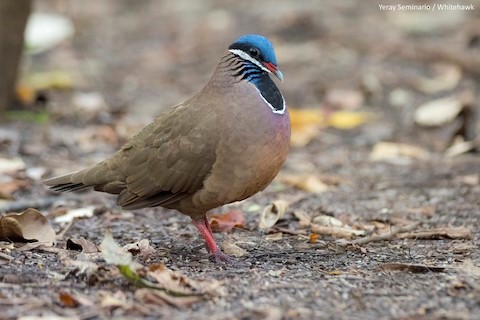
Blue-headed Quail-Dove. (Bermejas Wildlife Refuge, Matanzas, Cuba; February 27, 2019.) © Yeray Seminario
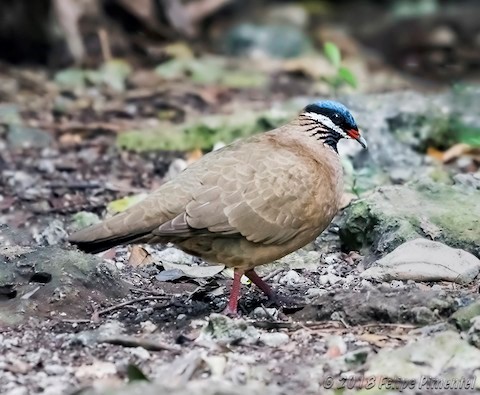
Blue-headed Quail-Dove. (Cueva de los Peces, Matanzas, Cuba; January 29, 2018.) © Felipe Pimental

Blue-headed Quail-Dove. (Bermejas Wildlife Refuge, Matanzas, Cuba; March 23, 2018.) © Arco Huang
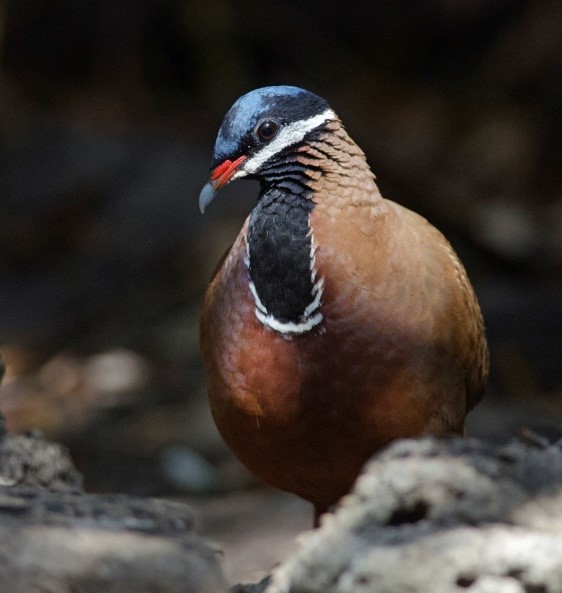
Blue-headed Quail-Dove, apparently a young bird with incompletely blue crown. (Cueva de los Peces, Matanzas, Cuba; February 14, 2017.) © Joshua D. Vandermeulen

Blue-headed Quail-Dove. (Cueva de los Peces, Matanzas, Cuba; July 18, 2017.) © Frantz Delcroix
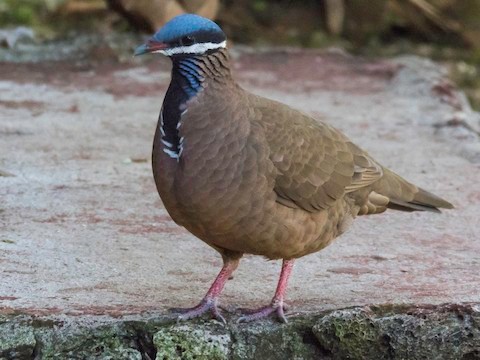
Blue-headed Quail-Dove. (Cueva de los Peces, Matanzas, Cuba; October 22, 2018.) © Sebastian Pardo
Peculiarly shaped, with a bulky, round body and neck usually held retracted. Often strikes unusual postures, pressing its chest to the ground and holding its tail high.

Blue-headed Quail-Dove, pressing its chest to the ground and holding its tail high. (Cueva de los Peces, Matanzas, Cuba; February 14, 2017.) © Joshua D. Vandermeulen
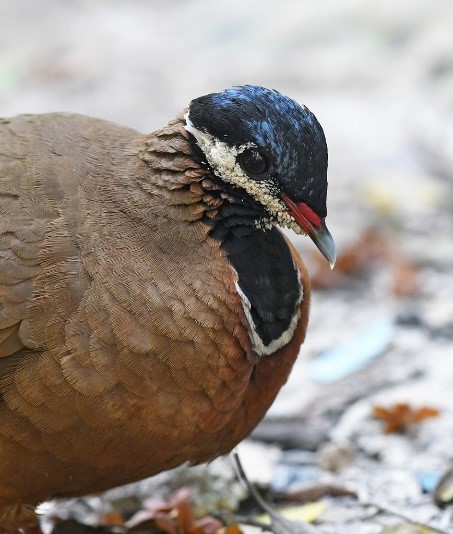
Blue-headed Quail-Dove, apparently a young bird with incompletely blue crown. (Cueva de los Peces, Matanzas, Cuba; February 11, 2019.) © Joshua D. Vandermeulen

Blue-headed Quail-Dove. (Cueva de los Peces, Matanzas, Cuba; February 14, 2016.) © Joshua D. Vandermeulen
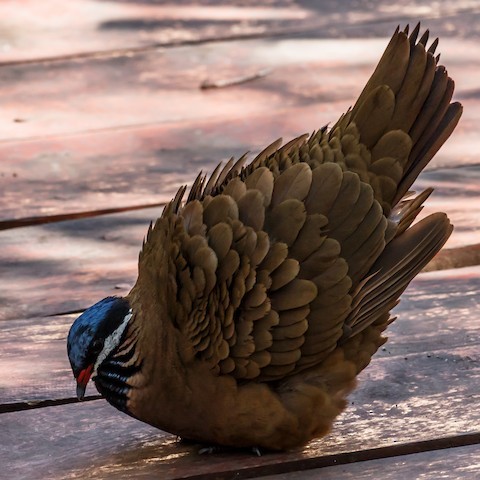
Blue-headed Quail-Dove, pressing its chest to the ground and holding its tail high. (Cueva de los Peces, Matanzas, Cuba; February 7, 2017.) © Carol Rose
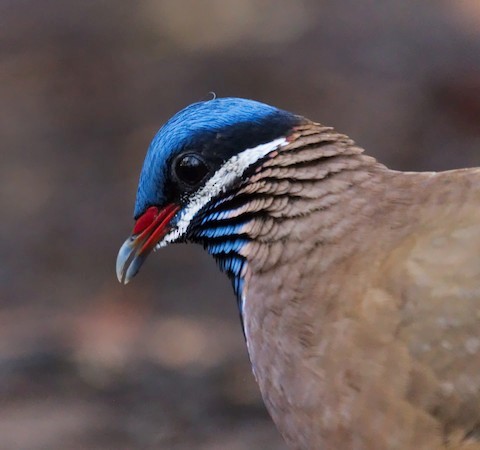
Blue-headed Quail-Dove. (Bermejas Wildlife Refuge, Matanzas, Cuba; March 27, 2019.) © Forrest Rowland
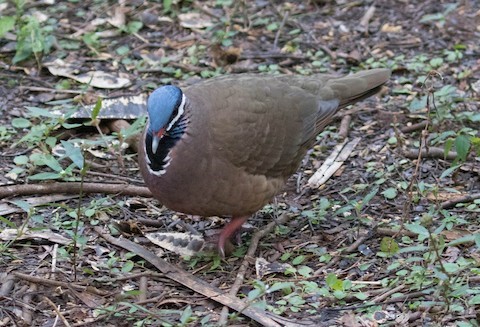
Blue-headed Quail-Dove. (Bermejas Wildlife Refuge, Matanzas, Cuba; January 16, 2018.) © Sandy Vayanos
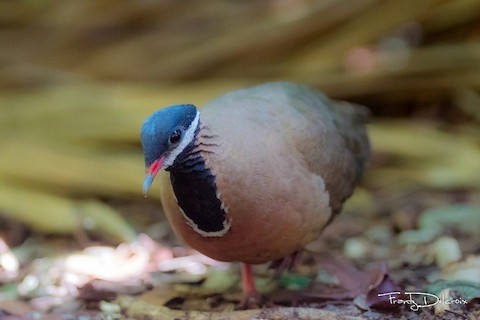
Blue-headed Quail-Dove. (Cueva de los Peces, Matanzas, Cuba; July 18, 2017.) © Frantz Delcroix
Notes
Monotypic species and genus.
IUCN Red List Status: Endangered.
References
Baptista, L.F., P.W. Trail, H.M., Horblit, and G.M. Kirwan. 2019. Blue-headed Quail-dove (Starnoenas cyanocephala). In Handbook of the Birds of the World Alive (J. del Hoyo, A. Elliott, J. Sargatal, D.A. Christie, and E. de Juana, eds.). Lynx Edicions, Barcelona. https://www.hbw.com/node/54256. (Accessed September 7, 2019.)
BirdLife International 2016. Starnoenas cyanocephala. The IUCN Red List of Threatened Species 2016: e.T22690970A93297219. http://dx.doi.org/10.2305/IUCN.UK.2016-3.RLTS.T22690970A93297219.en. (Accessed September 7, 2019.)
eBird. 2019. eBird: An online database of bird distribution and abundance. Cornell Lab of Ornithology, Ithaca, N.Y. http://www.ebird.org. (Accessed September 7, 2019.)
Garrido, O.H, and A. Kirkconnell. 2000. Field Guide to the Birds of Cuba. Cornell University Press, Ithaca, N.Y.
Gibbs, D., E. Barnes, and J. Cox. 2001. Pigeons and Doves: A Guide to the Pigeons and Doves of the World. Yale University Press, New Haven, Connecticut.
Navarro, N. 2015. Field Guide to the Endemic Birds of Cuba. Ediciones Nuevos Mundos, St. Augustine, Florida.
Raffaele, H., J. Wiley, O. Garrido, A. Keith, and J. Raffaele. 1998. A Guide to the Birds of the West Indies. Princeton University Press, Princeton, N.J.
